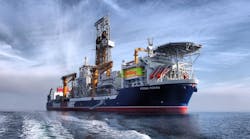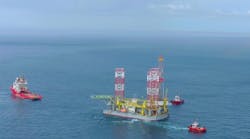Robin Dupre*Houston
HOUSTON – Oil and gas professionals believe that the United States has enough affordable natural gas production to meet rising and changing sources of demand, and that the country will be self-sufficient in oil in five to 10 years, according to a Deloitte survey titled, “2014 Oil and Gas Survey: The Next Chapter of the Energy Renaissance.” The topic dominated the conversation at Deloitte’s O&G conference recently held in Houston at the George R. Brown Convention Center
Even in the face of recent declining oil prices this optimism is still present among industry leaders.
“I have enormous optimism over the energy industry. Lower oil prices: We’ve done this before,” said Deloitte Vice Chairman and US Oil & Gas Leader John W. England in his welcome address at the conference. “Price volatility isn’t something new to us and change in our industry isn’t new to us. Prices, politics, or technology – change is always in the air in our industry. Change is a theme.”
He added that a key element of this topic is North America’s continuing ascendency in the overall supply picture.
“That becomes even more and more important if you think about the geopolitical unrest that the world is facing today,” he said. “With key producing countries like Russia and the Middle East and North Africa all having a fair amount of political unrest, it becomes even more important to have a stable supply that is North America.”
Production increases in North America over the last five years have been incredible, which contributes to the general sense of industry optimism, with more than 80% of survey respondents believing that the US energy situation has improved versus five years ago.
“What I envision in this new energy ecosystem is technology-enabled, highly efficient oil and gas production – a robust [industry] that can transport, process, and store hydrocarbons in ways that gives us enormous optionality in terms of how we monetize those hydrocarbons. But this story is not just a U.S. story, it’s a North America story.”
Canada, he noted, can be on the same path if producers are given access to get their oil to market. And now, the industry can include Mexico in this global picture, considering its recent energy reforms, allowing the country to ascend to its previous ranks as a world’s top crude-oil exporter.
England did take heed of a few challenges that the industry is experiencing, including public perceptions of technologies such as hydraulic fracturing, climate change claims, and water stewardship. England stated: “We have to educate the public about the industry and change the perception; we have to redefine the brand of oil and gas. Everybody with a Twitter account is a stakeholder. We have to address all those stakeholders that define the public perception of our industry.”
Another challenge facing the industry is increasing costs. More than half of survey respondents expect more capital spending in 2015. “The costs in this industry have gone up dramatically with the prices. It’s time to take a hard look at the cost structures and continue to think about how do we apply technology and innovation to bringing down costs and to getting our costs in line with lower prices.”
Adam Sieminski, administrator for the US Energy Information Administration, in his keynote address, provided an international energy outlook. With renewable and nuclear being the fastest growing sources of power globally, oil will maintain its leading market share throughout the entire projection period through 2040. He added that almost all of the growth in energy consumption is going to be taking place in the developing world. Not in the OECD countries, he pointed out, but in the countries outside of the OECD where both population and economic growth is really moving.
“Increased demand is going to require something like 33 MMbbl of more oil,” Sieminski stated. “Where is all that oil going to come from? How much of it has to come from OPEC versus non-OPEC sources? Interestingly, a big piece of it is coming from the United States, right now.” The EIA predicts that by year-end, the US will witness about 8.6 MMboe/d of production. “No matter what number you get, a few weeks later, it’s bigger. Maybe this decline in oil prices is going to slow that down a bit, but we’ll have to wait and see.”
Several oil forecasts from previous years, Siemenski noted, had numbers that went up, plateaued, and then drifted down. “Why have we not been able to get this right? The answer is technology has been moving so rapidly that it’s really hard to keep up. It’s a combination of increasing drilling efficiencies, so the rigs can drill more wells from the same pad -- drill longer wells at a faster pace. The production coming from those wells is more efficient, more hydraulic fracturing or frac stages, figuring out how to minimize trips of the drilling strings. The technology of well completions is just improving tremendously, and that’s the kind of thing that’s hard for any forecast to actually pick up, that change in the technology.”
This increase in North America production will offset unplanned outages in countries like Iran, Libya, Iraq, and the Sudan. Sieminski noted that the US would probably become a net exporter of natural gas by 2016 and a net exporter of oil in the late 2020s.





